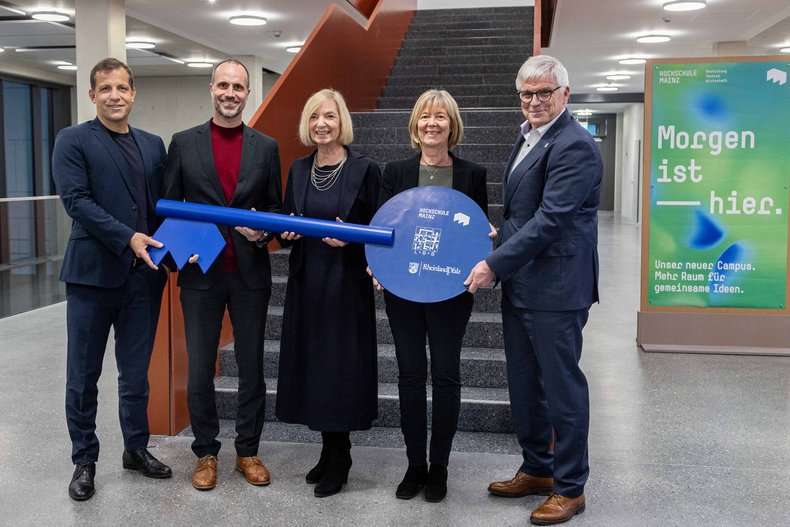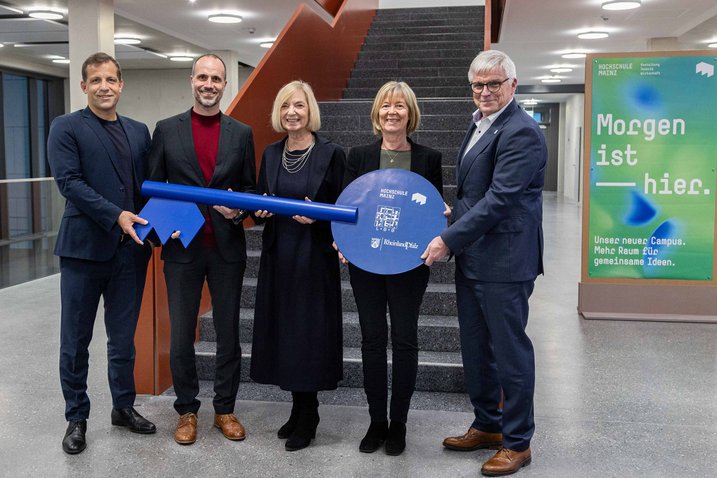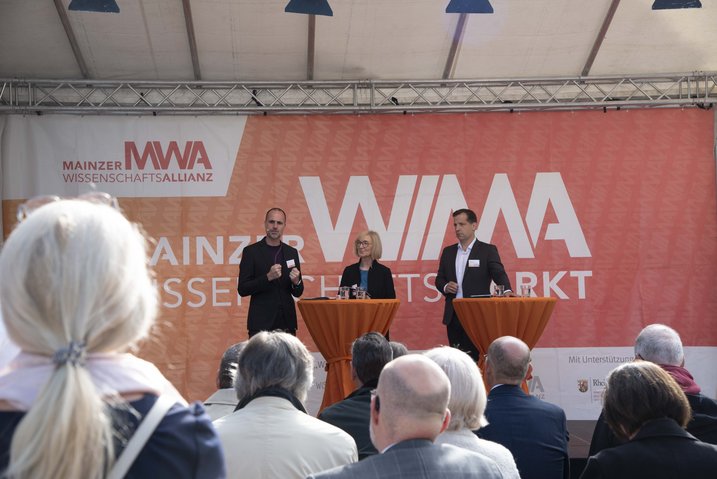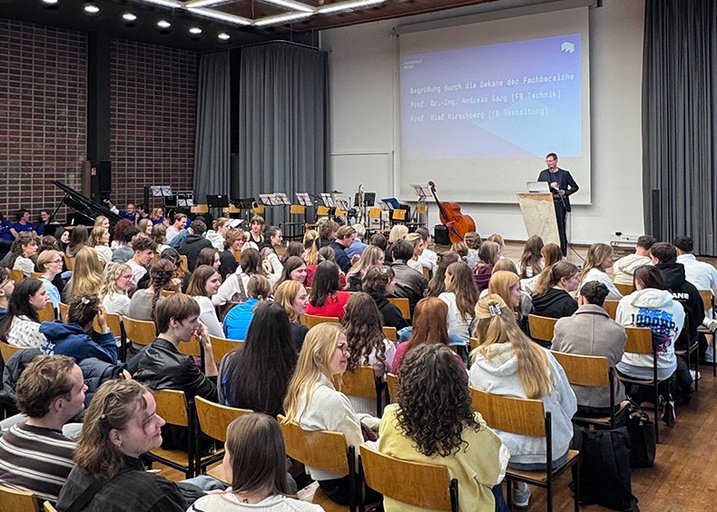At a ceremonial key handover on October 27, 2025, the Landesbetrieb LBB (State Property and Construction Management Agency) officially transferred the newly completed building to Mainz University of Applied Sciences, marking the completion of the second construction phase. Speakers at the ceremony included the President of Mainz University of Applied Sciences, Prof. Dr. Susanne Weissman, Finance Minister Doris Ahnen, Science and Health Minister Clemens Hoch, Mayor of Mainz Nino Haase, and Holger Basten, Managing Director of the State Agency LBB, whose Mainz branch manages the new building. The key handover marks the official start of the subsequent relocation process from the downtown locations.
With the expansion of the Mainz University of Applied Sciences campus, all three schools will be united at a single location on Lucy-Hillebrand-Straße. This spatial proximity will foster future synergies in teaching, research, and knowledge transfer.
Prof. Dr. Susanne Weissman, President of Mainz University of Applied Sciences, emphasized, “This newly emerging location allows us to engage in collaborative and interconnected innovative research and teaching much more than before. The new facilities and resulting situation enable significantly more opportunities for exchange without great effort: Students, researchers, and staff from different disciplines can connect more easily, which will certainly benefit interdisciplinary projects and new approaches.”
New building with approximately 13,000 square meters of floor space
Mainz University of Applied Sciences currently has around 5,500 students. The first construction phase already houses the School of Business and the School of Engineering with the Department of Applied Informatics and Geodesy. Over the coming months, the new building with approximately 13,000 square meters of floor space will gradually accommodate the School of Engineering with the Architecture and Civil Engineering departments and the School of Design with the Interior Architecture and Communication Design departments, which are currently located on Holzstraße and Rheinstraße. The Time-Based Media degree program, focusing on audiovisual and interactive digital media such as audio, film, and 3D animation, will remain at the Wallstraße location.
The new building provides space for research, teaching, and administration. This includes various workshops and laboratories, a two-story hall for structural engineering, and a building materials testing lab including a strong floor. Additionally, there are 36 seminar and administrative rooms of various sizes, as well as student workspaces covering nearly 1,400 square meters. The compact building structure features two interior courtyards. The spacious connecting passage (Magistrale) created in the first construction phase has been continued in the second phase and opens outward with the new central reception area. The concept for the outdoor facilities continues with additional deciduous trees, shrubs, perennials, and grasses, as in the first construction phase. As part of the second construction phase, 312 additional bicycle spaces will be installed. The groundbreaking took place in June 2020, and the traditional topping-out ceremony in September 2021.
Finance and Construction Minister Doris Ahnen stated, “With the completion of the second construction phase, this location becomes a central knowledge hub with tailored conditions for applied sciences. In total, the State of Rhineland-Palatinate has invested 76 million Euro in the second construction phase to bring the university together on its campus at Lucy-Hillebrand-Straße. This underscores the fact that modernizing and expanding university properties is among the most important goals of the State of Rhineland-Palatinate. Research and science are the foundation for technological, economic, and social progress. The building is also exemplary in terms of sustainability, having taken not only ecological but also economic, sociocultural, and functional aspects and qualities into account in its construction.”
“With this campus expansion, science is moving closer together here in Mainz. Not only is the university being concentrated at one location, but science is also being pooled together with Johannes Gutenberg University and research institutions. This makes science even more visible here in Mainz and contributes significantly to the region’s innovative capacity,” said Science Minister Clemens Hoch.
New building section will be gradually put into operation by faculty and students
Following the key handover, the newly completed building section will be gradually put into operation and used by faculty and students. The installation of university-specific equipment and targeted installations by the university to finalize the adaptation of the spaces for their respective uses will take place promptly. The move from the two old locations on Holzstraße and Rheinstraße will take place in stages and in close coordination with teaching activities to ensure continuous and uninterrupted academic activities. The complete relocation of all functions to the new location is planned by the end of the 2026 summer semester, meaning by the end of September 2026.
Mayor Nino Haase said, “The signal currently being sent out is extremely positive and forward-looking: The university location will soon be strengthened on the highest technical level, with university education facilities situated in immediate proximity to one another. This creates optimum conditions for young academics in research and teaching—and for their invaluable impact on the regional business community, project ideas, and our city’s society as a whole. A focused knowledge hub is being created in the state capital with the university now being at one central location, as well as JGU, Life Sciences, and the Biotech Hub, which is internationally appealing and will simultaneously enable unique collaborations and synergies. In addition, it is absolutely essential for our urban development to anticipate occupying our property on Holzstrasse in the foreseeable future.”
LBB Managing Director Holger Basten explained, “For the university expansion site, including areas for university-related businesses, the City of Mainz has set clear urban planning goals to preserve the fresh air corridor and minimize negative climate impacts. The second construction phase of the university also meets these urban planning conditions, even though it offers almost one and a half times as much floor space as the first. By recessing the lower floors and the interior courtyards while maintaining good daylight, the permitted building height could be maintained—particularly important for the fresh air corridor. Like the first construction phase, the new building is functionally planned and convincingly designed with the use of limited materials. One special feature is the continuation of the central connecting structure, the Magistrale, also intended for use as an area for communication and student work, boasting a new central entrance.”
The first construction phase, officially opened in 2009, already nearly achieved low-energy building standards. The second construction phase aims for the Silver Standard under the Federal Sustainable Building Assessment System (BNB) introduced in 2010. Here, sustainability refers to ecology, economics, and the sociocultural and technical aspects of the building.
In addition to the two university buildings, the university campus will also include the LUCY building from spring 2026 onwards, which will offer student workspaces and event rooms. Furthermore, Mainz University of Applied Sciences will continue to maintain a presence in the city’s downtown area with its LUX Pavilion and the location on Wallstraße.
Art in architecture: Zollstock marks new campus entrance
As part of the state-funded Kunst am Bau (Art in Architecture) program, the six-meter-high sculpture Zollstock (folding rule) by the Berlin artist collective inges idee was installed at the new campus entrance of Mainz University of Applied Sciences in the summer. The dynamic sheet steel sculpture symbolizes measuring, determining, and verifying with an oversized, unfolded yellow folding rule—as a unifying element connecting the three schools of Design, Engineering, and Business. The sculpture stands as a humorous bridge linking analog traditions and digital developments, emphasizing the dynamic forward-looking orientation of Mainz University of Applied Sciences.
Image campaign “Tomorrow starts here” launches
To coincide with the key handover, Mainz University of Applied Sciences is launching its image campaign “Tomorrow starts here – Our new campus. More room for collaboration.” With the expanded shared university campus in direct proximity to Johannes Gutenberg University Mainz, the MEWA Arena, and the emerging Biotech Campus, a center for applied sciences is taking shape that, with its diverse range of degree programs and numerous partnerships with innovative companies, is a forward-looking addition that fits perfectly into the thriving science hub of Mainz.




